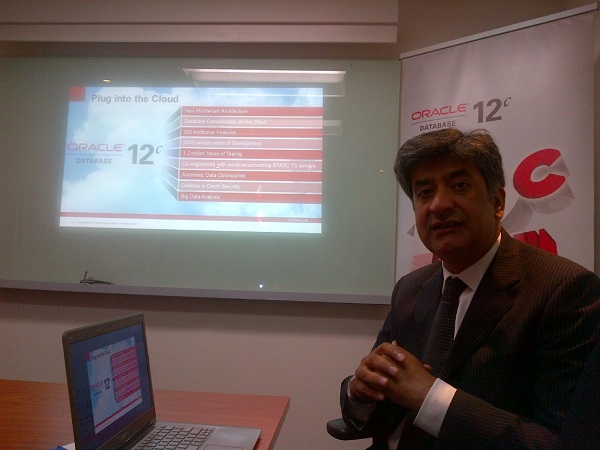
Kaleem Chaudhry, Oracle Asia Pacific Regional Director for Enterprise Technology, explains to reporters the benefits of Oracle’s Database 12c version that helps businesses provide online services faster.
MANILA, Philippines – Businesses that are looking to provide online services will find it as easy as filling up a form online with the new Oracle Database 12c version launched recently in the Philippines.
Database 12c is a major upgrade from their previous Database 11g version released five years ago, bringing 500 new features that will help businesses to embrace cloud computing technology faster, the international computer technology company said.
“Cloud is the ability to access your computing resources through the Internet and not only access it but be able to request [how much resources] you want,” Kaleem Chaudhry, Oracle Asia Pacific Regional Director for Enterprise Technology, said during a roundtable discussion last August 15.
“So for any cloud environment you should be able to go over and connect and fill in a form and say ‘I want this’, and the moment you hit the submit button you should get that environment to your business users,” he said.
Database 12c has a new “multitenant architecture, which allows the management of multiple databases as if it were just one, saving time and effort on the maintenance of hundreds of databases, Chaudhry said.
The management of many databases has been a major challenge for database administrators especially in the utilization of computer resources as well as the time and effort needed with upgrades, backup, data recovery, etc. that need to be applied to each individual database.
Computer resources are also used more efficiently under the new architecture. Chaudhry said that 50 individual databases would be using up 20GB of memory but 250 databases could run on the same amount of memory under the “multitenant architecture.”
“Gone are those times when you [had] to procure hardware and software [first] before rolling out a business functionality [which] used to take six months. But with the cloud, you come to the internet, you request the computing resources that you need, and you get that resources created for you on the fly,” Chaudhry said.
“That’s the benefit of cloud and this version of Oracle Database allows [businesses] to make that a reality,” he said.
Another feature is the Automatic Data Optimization which group data based on how actively they were being used. Frequently accessed data would be put into high-performance storage, moderately accessed data are stored on medium-performance storage, and the least active data are archived in low-performance and low-cost storage.
This allows for cost-savings while maintaining the performance of servers, Chaudhry said. He also emphasized the rapid elasticity feature of Database 12c which allows clients to quickly adjust the amount of computer resources they have depending on business demands.
“All the large telecommunication companies, all the large banks, all the large conglomerate groups, they need to advance their data center [so that] when their line of businesses and business users need to roll out a business functionality, they do not need to wait for months and years to get that rolled out,” Chaudhry said.
“They want to have the capability where they can, over the Internet, access and fill a form, say ‘I need that many CPUs, I need that database server, I need that application’ and that environment gets created for them on the fly,” he added. “The benefits are so huge there is no customer that would not want it to happen, because it reduces the time to market for the business significantly and it enhances the competitive edge that a business has.”